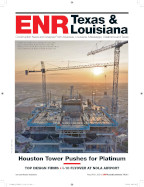NREL ESIF Garners LEED Platinum
The Energy Systems Integration Facility on the campus of the U.S. Dept. of Energy’s National Renewable Energy Laboratory in Golden, Colo., has earned a LEED-Platinum certification for new construction.

The 182,500-sq-ft ESIF is an Energy Department User Facility that is the nation’s first to help both public and private sector researchers scale up promising clean-energy technologies and test how they interact with each other and the grid at utility scale.
ESIF houses more than 15 experimental laboratories and several outdoor test beds, including an interactive hardware-in-the-loop system that lets researchers and manufacturers demonstrate their products at full power and real grid-load levels, up to 1 MW in scale.
The facility also features a high-performance computing (HPC) data center designed to be one of the most energy-efficient data centers in the world because of its innovative warm-water cooling system. It is expected to achieve an annualized average power-usage effectiveness (PUE) rating of 1.06 or better.
Typical data centers achieve a rating of approximately 1.80 PUE is defined as the ratio of total power to run the data center facility (IT equipment, lighting, HVAC, uninterruptible power supply systems, etc.) to the total power drawn by all IT equipment.
“ESIF is a dynamic facility with many mission critical functions, including high-bay labs capable of utility scale research, a high-performance computer and datacenter as well as an office wing for 200 researchers,” said Drew Detamore, NREL’s deputy director of SITE Operations. “It was a challenge from the start to not only make the facility energy efficient, but to go beyond everyone's expectations and achieve LEED Platinum.”
With so many distinct, yet integrated, sections to ESIF, the design-build team of SmithGroupJJR and JE Dunn Construction incorporated a range of advanced sustainable design technologies and best practices throughout. Natural light enters deep into ESIF through 15-ft-long skylights and large expanses of clerestory glazing, allowing electrical lights to be shut off between 10 a.m. and 2 p.m. daily in the office and laboratory buildings.
Operable windows enable natural cooling and ventilation throughout the building, and solar powered fans aid in extracting heat from offices. A model of sustainability, 78% of construction waste was recycled or reused while 27% of the facility is comprised of recycled materials.
The result was a whole-building, integrated design that offset energy challenges, for example, heating high-bay labs by using the waste heat from the 10,000 square-foot HPC data center. NREL chose the warm-water cooling system for the HPC data center because water has approximately 1,000 times the cooling capacity of air, making it more energy efficient to pump in a cooling system versus the energy needed to run a fan to move cooling air, which is the typical for data centers. The warm-water cooling systems distributes waste heat throughout ESIF, which helped earn energy efficiency points for the LEED rating.
NREL estimates that leveraging the energy-efficient HPC data center will save approximately $1 million in annual operating cost compared to a traditional data center. The cost savings are due to a potential $800,000 in electrical-energy savings and $200,000 thermal-energy savings from reuse of the waste heat to heat ESIF.
ESIF achieved all 56 LEED points applied for, and the facility is 40% more energy efficient than the baseline building performance rating per ASHRAE/IESNA Standard 90.1-2004. It becomes 46.2% more efficient with the addition of a 720 kW photovoltaic solar array located on nearby South Table Mountain.
“NREL strives to conduct its research and operations in the most sustainable manner,” NREL Senior Sustainability Project Manager Michelle Slovensky said. “We work to minimize the impact of doing business by balancing environmental, economic and social resources. Utilizing our campus as a living laboratory enables the continued evaluation and improvement of building design approaches and technologies that facilitate their transfer to the marketplace.”
The ESIF is the fifth facility at NREL to achieve a LEED-Platinum designation. In 2007, NREL’s Science and Technology Facility was the first federal facility in the nation to be certified LEED Platinum. In June 2011, the initial Research Support Facility was certified LEED Platinum; followed by a November 2012 LEED designation for the RSF expansion. In July 2013, NREL’s state-of-the-art, energy-efficient cafeteria also received a platinum-level rating.




